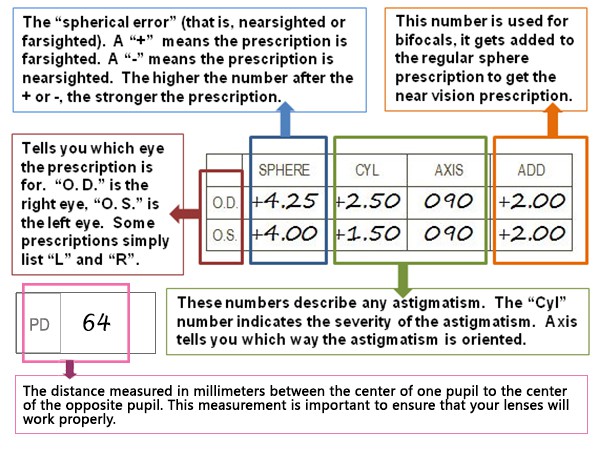
Eyeglass Prescription – How to Read and What It Means
After visiting your optometrist or ophthalmologist for an eye exam you may be wondering what all of those numbers and terms written on your eyeglass prescription mean. If you didn’t know before, now you should know whether you’re nearsighted, farsighted or maybe you have astigmatism.
Let’s help you clarify what all those abbreviated terms and numbers mean.
This is a brief guide to help you understand your prescription better. Let’s take a look at this sample prescription below.
What is OD and OS?
These abbreviations stand for the Latin words oculus dexter(Right Eye) and oculus sinister(Left Eye). Your prescription might also have a column labeled “OU.” This abbreviation is taken from the Latin term oculus uterque, meaning “both eyes.”
Some doctors have chosen to update their prescription terms and simply mark their prescriptions with RE (Right Eye) and LE (Left Eye).
The information for your right eye is listed first because when your eyes are examined the doctor is facing you and will look at your right eye first.
What is SPH or RX?
This column indicates the lens power used for correcting your eyesight. This lens power which is measured in diopters corrects nearsightedness or farsightedness. A number preceded by (-) means you are nearsighted; a (+) or no plus/minus sign in front of the number means you are farsighted.
Doctors use the term sphere because the correction is “spherical” or equal in all meridians of the eye.
What is CYL?
This abbreviation means “Cylinder.” This number signifies the amount of lens power to correct astigmatism. If this column is empty then you don’t have astigmatism or it is so small that it isn’t necessary to correct with eyeglasses.
What is Axis?
This number is only present when the previous column for CYL has a number written. The axis indicates what angle the CYL power is processed into the eyeglass lens. The axis will have a number from 1 to 180.
What is ADD?
This signifies the added magnifying power that is found on the bottom part of the eyeglass lens to correct presbyopia. This number is listed will always be positive.
What is PD?
PD stands for Pupillary Distance; the distance measured in millimeters between the center of one pupil to the center of the opposite pupil. This measurement is important to ensure that your lenses will work properly.

Comments are closed.